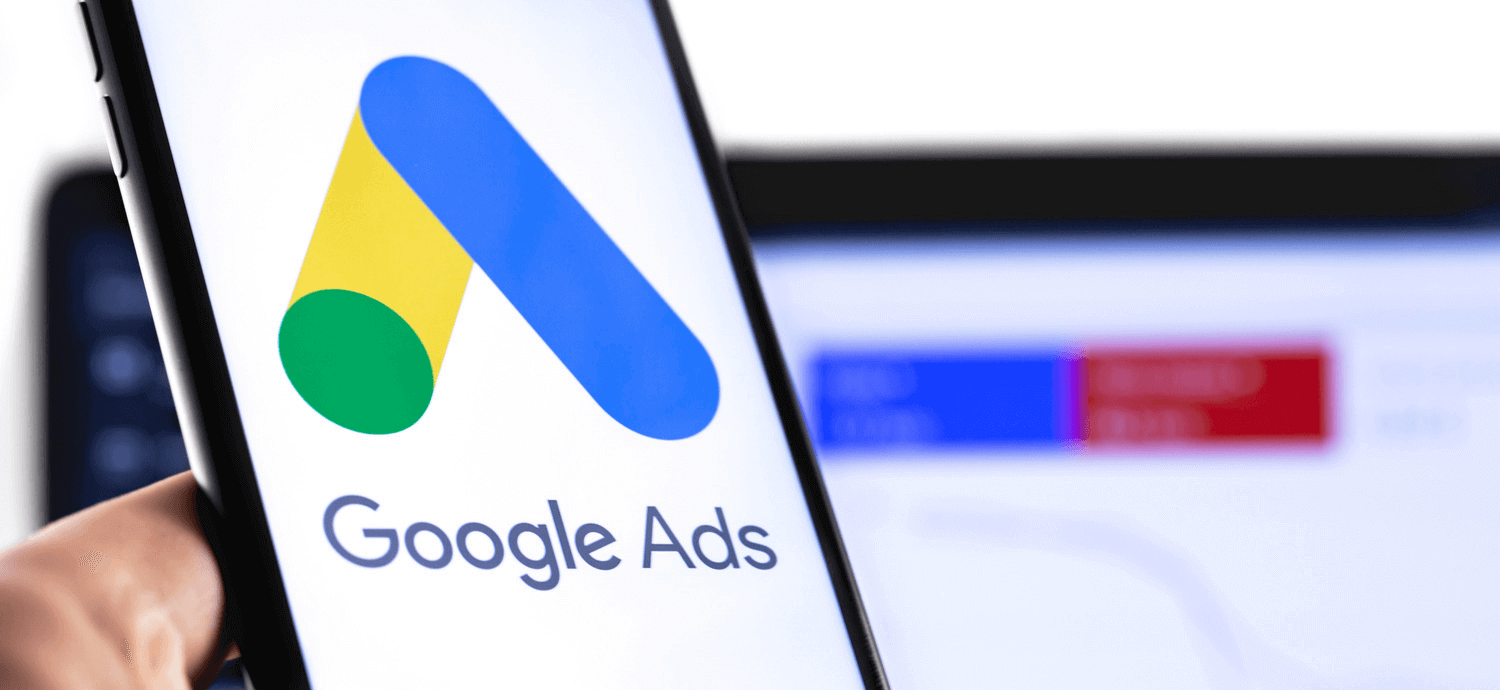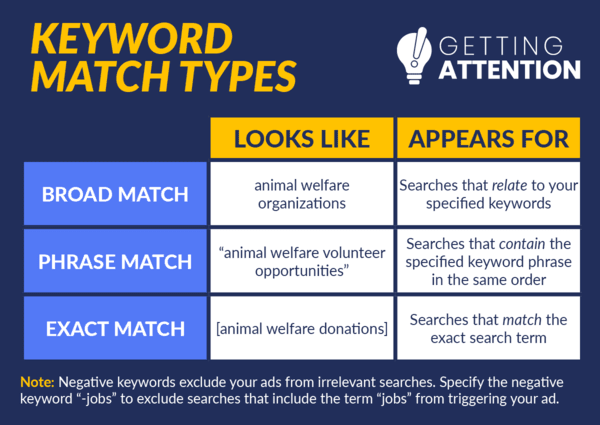
Are you getting the most out of your Google Ad Grants? Could common errors be impacting your campaigns’ success?
Many nonprofits struggle to fully capitalize on the Google Ad Grant. For instance, your keywords might target the wrong audience, or you may not be leveraging tools effectively.
All hope isn’t lost, though! You just need to make some adjustments to improve results. Whether you’re considering applying for the Google Ad Grant or your account’s performance isn’t meeting expectations, here are the top mistakes that might be holding your campaigns back.
1. Poor Keyword Selection
Keywords determine when your ads appear. Nonprofits often choose keywords that are too broad, irrelevant, or highly competitive, which leads to poor ad performance and wasted grant money.
However, selecting the right keywords will help your nonprofit attract relevant traffic, improving the likelihood of connecting with visitors genuinely interested in your services and mission. It can also boost your ads’ quality score and reduce your cost per click (CPC) rate. That means you’ll improve your ad spend and target users more likely to engage with your organization.
How To Avoid This Mistake
Google Grants experts know how to conduct keyword research, so hiring an agency is your best bet if you’re struggling with keywords. In the meantime, here are some quick tips to improve your keyword selection:
- Use specific keywords. For instance, “mentor programs for teens” will directly target the intended audience and service. In contrast, a generic keyword like “youth services” might be too broad and attract unrelated searches.
- Use a paid account to bid on very competitive keywords. This will allow you to compete for high-traffic keywords that are typically restricted or too costly under the limitations of Google Ad Grants, such as those with high CPCs.
- Understand the types of Google Ad keywords. Getting Attention’s Google Grants keyword guide explains the different keyword types that Google Ads accounts use. Phrase match keywords target searches containing the specified keyword even if there are other words in the search, and broad match keywords trigger ads for searches that include keyword variations and related terms. You can use exact match keywords to only trigger your ad for the exact search term and close variants, or use negative keywords to prevent ads from appearing for irrelevant searches.

After implementing these tips, monitor keyword performance and adjust your strategy as needed.
2. Not Maximizing Ad Assets
Ad assets, formerly called extensions, expand your ads on Google Search. Some nonprofits neglect to use available ad assets. However, these features enhance ads’ visibility and provide additional information to visitors. By leveraging ad assets, your nonprofit can improve its click-through rate (CTR), provide direct pathways to relevant pages, and communicate its mission and services.
How To Avoid This Mistake
Make sure you understand the different ad assets available to Google Grants users. While 19 are available, some are more useful than others, such as:
- Sitelinks add more landing page links, providing searchers with more opportunities to engage with your nonprofit.
- Call and location assets add your organization’s address and phone number, making it easy for people to find and call your organization.
- Callouts and structured snippets highlight specific aspects of your services by listing them in plain text.
- Lead form assets gather user information (like sign-ups or contact details) through a form embedded in your ad.
Just like ads and keywords, assets can be approved or disapproved. Even if your asset is approved, it’s not guaranteed to always show with your ad. Google will automatically show it if the asset is predicted to improve your ad’s performance or if your ad’s position and Ad Rank are high enough.
For context, Ad Rank determines if and where your ads appear on a page based on factors like bid amount, ad and landing page quality, auction competitiveness, search context (e.g., the person’s location, device, time of search, and search terms), and the potential impact of ad formats and assets.
3. Not Adhering to Google’s Rules and Requirements
You need to meet Google Grants eligibility requirements to be accepted into the program, and there are also requirements for maintaining eligibility. Falling out of compliance can result in grant suspension. Common issues include failing to set up conversion tracking and improper ad formatting.
How To Avoid This Mistake
To avoid compliance issues, follow these tips:
- Understand your account structure. Google has several rules regarding account structure. 360MatchPro’s Google Ad Grant optimization guide explains that your account is made up of campaigns. Each campaign has multiple ad groups, and each ad group has multiple ads. Google requires Google Ad Grant users to run at least two campaigns. Also, know that Responsive Search Ads have replaced the old Google Ad format, so you no longer need multiple ads in each group.
- Revisit the rules. Every so often, the Google Ad Grants team will change their requirements, so regularly review policy changes and adjust your campaigns accordingly. Better yet, work with a Google Grants agency to stay on top of these changes.
- Monitor performance metrics. Focus on your account’s KPIs, such as CTR and conversion rate. Very few accounts fall below the required CTR, but you should still pay attention if you’re advertising in a highly competitive sector. For example, an estimated 5% of all Google searches are health-related, making advertising competitive for healthcare organizations and hospitals.
The Google Ad Grant rules exist to help your account perform better, not make it difficult to participate in the program, so follow the rules!
4. Targeting All Countries and Territories
In an effort to get as much traffic as possible and spend the full grant, some nonprofits target all countries and territories. However, that leads to low engagement and poor conversion rates. Aiming your ads globally can dilute your efforts and waste your grant.
Let’s say a person in Brazil registers for counseling services exclusively available to Canadian residents. While this registration would still count as a conversion in Google Ads, the nonprofit would need to discard this application, wasting internal resources. Plus, you might not be able to legally solicit donations from users in certain states.
How To Avoid This Mistake
Google Ad Grant training resources can help you understand the more advanced parts of your account related to ad targeting. In the meantime, here are some easy solutions for targeting the right areas:
- Use geo-targeting. Select specific regions, countries, or cities your nonprofit services and where your audience is located. This makes your campaigns more relevant to Google users and increases the likelihood of engagement. For example, you might advertise your zoo in its city and nearby communities to connect with a local audience.
- Localize your content. Tailor your ad content to reflect local issues, events, and needs to increase relevance to your community and connect with your audience.
- Analyzing audience data. Regularly review your Google Analytics and Google Ads data to understand where your engaged audiences are located. This data can help you focus on areas with high potential for impact.
Avoid wasting your Google Ad Grant on unproductive traffic, so you can improve the overall effectiveness of your digital advertising efforts.
Wrapping Up
When it comes to marketing your mission, search ads can complement your SEO efforts and boost website visibility. Bring in high-quality leads by avoiding wasting your Google Ad Grants budget on targeting general audiences or low-quality keywords. Be patient, pay attention to KPIs, and reach out to a professional Google Grants manager if you need help! In no time, you’ll improve your ad performance.